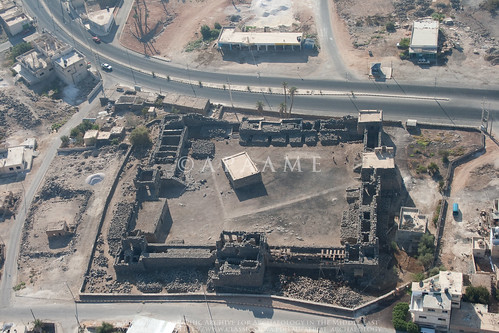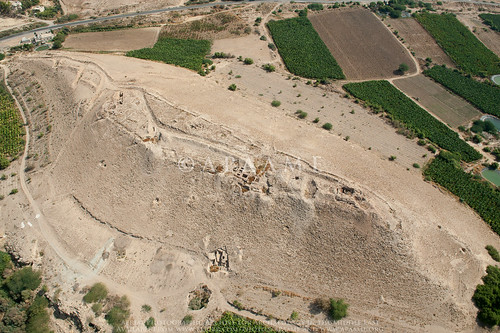The American Journal of Archaeology for January-March 1923 published the abstracts of lectures given the previous December at the annual conference of the Archaeological Institute of America (AIA). One abstract is entitled “The Aeroplane and archaeology”, the author a professor at University of Rochester in New York State. Sadly, never published and tantalizing because of what MacLean had to say:
“Among the many services which the aeroplane is rendering at the present time not the least is the aid which it is giving in archaeological discovery. In countries such as Mesopotamia where there are few maps to guide the archaeologist, and in portions of Arabia which are difficult of access by ordinary means of travel, the aeroplane has already proved to be a valuable subsidiary help in making preliminary surveys, and in locating historical ruins and the possible sites of ancient cities. Two illustrations will suffice. This last summer I went by aeroplane from Amman in Transjordania to visit some Roman ruins at ‘Kasr Azraq’ in the Syrian desert. … Another noteworthy feature was the presence on the oasis of about twenty pools of clear cold water surrounded by a Roman wall. It was interesting to observe that while this wall, only portions of which remain, could hardly be distinguished by an observer on the ground, its alignment and complete circuit of the pools could be seen clearly from the air.
My second illustration is from Mesopotamia. Among the many lost cities of ancient times may be mentioned two which Xenophon speaks of in the Anabasis …. Until quite recently the difficulty in determining the site of these two cities was due to the fact that the course of the Tigris in ancient times was not known to us. But by recent observations and photographs taken from the air it is now pretty well established that that portion of the Tigris which lies to the east of Xenophon's Median Wall had its bed about fifteen miles to the west of the present bed of the river. The depression seen from the air and the line of mounds along the depression were the clues which led to what is thought to be the discovery of the sites of both Opis and Sittace.”
Quite apart from what MacLean is ‘discovering’ from the air and what other aerial photographs he may have had, is the puzzle about how he came to be in a position to fly over these places at all, especially in the case of Azraq which was the specific object of the flight.
 |
| Qasr el-Azraq today. APAAME_20080909_IAR-0205. |
MacLean, the son of Scottish immigrants to Canada, is said to have been:
“… teaching at the University of Manitoba when World War One broke out. He enlisted immediately, in August, 1914, in the Winnipeg Grenadiers and landed in England with the first Canadian contingent in October of that year. He was commissioned as an officer in the British Imperial Army in January, 1915, and served in France for eight months. In 1916 he was sent to the Middle East where he served in various capacities and in various countries - Mesopotamia, Persia, Arabia, and India. For the last year of the war he was engaged in political work, coming into contact with such personalities as Gertrude Bell, H. St. John Philby, Sir Percy Cox, and Col. T. E. Lawrence.”
He is described as having “served as staff captain under General Maude, being engaged particularly in intelligence and political work” and elsewhere he said he “arrived in Bagdad with the British army on 11 March 1917”. MacLean was soon moved westwards and is described as having been a “member of General Allenby’s staff when the British army marched on Jerusalem”.
In the magazine of his university he recounts the flight of 1922 which evidently included the flight to Azraq. Although he does not say so, he was evidently flying across Jordan and Iraq in one of the RAF aircraft of the newly developed Airmail Route from Egypt to Basra, initiated in June-July 1921. The few passengers carried were normally only service or important government personnel, implying MacLean had some influence.
MacLean explains he was in Baghdad as part of the celebration marking the laying of the foundation stone of the University of Baghdad and that he also met King Feisal. Returning west, his aeroplane had engine trouble and they had to land and spend a night in the desert.
There is much more one may add but two salient points to note are that MacLean is untraceable in the records of those who have spent many years researching military intelligence in the Middle East during the First World War. On the other hand, if he was – like that other oddity in the region, Richard Meinerzhagen, a fantasist, he nevertheless seems to have known enough people of influence to be given a flight to Azraq, taken on two trips on the new Airmail Route, perhaps also flown by the RAF in Iraq and supplied with some aerial photos for his lecture.
Sadly, one avenue of research is closed. MacLean’s sole child, a son, is long dead and had been estranged from his father for many years; the son’s children, brought up in France and French citizens, came to me for information about their grandfather.
But there must be some record of his First World War service and perhaps how that led to his flights in 1922. Perhaps he really did know Bell, Philby, Cox and Lawrence. In 1922 the senior British Political Officer in what they still called Transjordania was … Harry Philby. Shortly after MacLean flew across Jordan, Meinerzhagen crossed it on the ground. At the far end of the route, MacLean would have found the British residents of Baghdad included both Gertrude Bell (Oriental Secretary) and Sir Percy Cox (High Commissioner for Iraq).
Many of the personal details of MacLean’s long life and career have been traced as have his publications (including two books published privately). The gap is his military service.
– David Kennedy
























.jpg)

.jpg)
.jpg)
.jpg)














